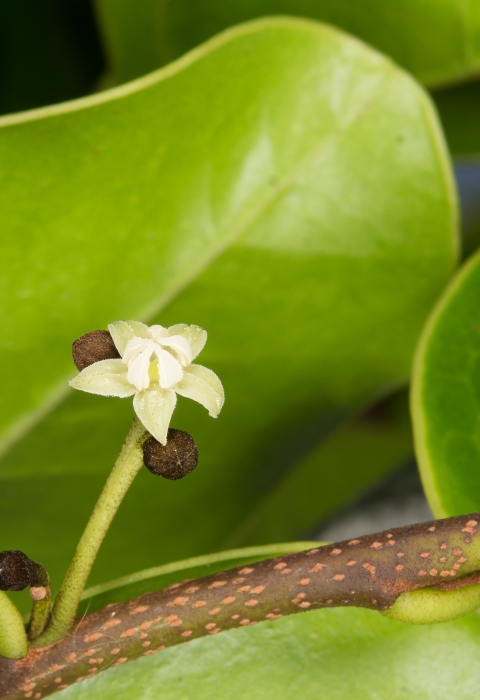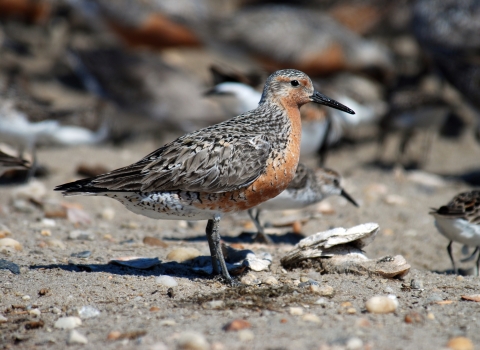What is palo de rosa?
Palo de rosa is the common name of Ottochulzia rhodoxylon, an evergreen tree that may reach up to 49 feet (15 m) in height and 16 inches (40 cm) in diameter. Its common name comes from its pink colored wood. Palo de rosa also has smooth, dark gray branches and bisexual flowers arranged singly or in clusters at the leaf bases. The fruit is about one inch long and almost one inch wide, smooth and has a thin covering that turns dark purple when ripe. This species was listed in 1990 as an endangered species under the Endangered Species Act (ESA), due to low number of individuals and limited distribution throughout Puerto Rico.
What is the range of palo de rosa?
Palo de rosa extends along the southwestern coast of Puerto Rico, from the municipality of Cabo Rojo to the municipality of Guayanilla, and along the northern coast of Puerto Rico, from the municipality of Aguadilla to the municipality of Fajardo. Although the species’ native range extends to the island of Hispaniola (Dominican Republic and Haiti), there is little information on the status of the species in those countries and the sparse information found is limited to scattered herbarium collections.
What is the population status of palo de rosa?
According to a review of the best available information for the species, about 1,144 palo de rosa individuals are found in 66 subpopulations throughout Puerto Rico. Overall, about 70 percent of the areas where palo de rosa are known to occur are areas which are either protected, managed for conservation, recognized by local agencies as important for conservation, or areas of difficult access because of the topography. In Hispaniola, there is little information of the current status of this species. However, palo de rosa is categorized as critically endangered according to the red listing assessment for the flora of the Dominican Republic.
Why is the Service proposing to reclassify palo de rosa from endangered to threatened?
After a thorough review of the best scientific and commercial information available on the species, the Service found a significant improvement on palo de rosa’s overall status and a reduction on the threats affecting the species. Therefore, the Service has determined that palo de rosa no longer meets the ESA definition of an endangered species and should be reclassified as threatened.
How are the endangered and threatened classifications defined?
The ESA defines endangered as “in danger of extinction throughout all or a significant portion of its range” whereas threatened is defined as “likely to become an endangered species within the foreseeable future throughout all or a significant portion of its range.”
What prompted the Service to take this action?
In 2017, the Service completed a 5-year status review that recommended the reclassification of palo de rosa from endangered to threatened, based on the substantial improvements in its status. Since listing in 1990, and as stated on the 2017 5-year status review, a substantial increase in number of individuals have been documented (1,144 individuals including adults and saplings) from 66 localities (subpopulations) throughout Puerto Rico. Furthermore, more than half of the known localities (about 70 percent of the localities) occur in areas under some conservation or protection mechanism, providing favorable conditions for the recovery of the species.
What recovery actions have been implemented to lessen the threats to the species?
The Service, in collaboration with local partners, has successfully implemented the following recovery actions:
- Preventing loss of habitat and populations;
- Continuing to gather information on the distribution and abundance of palo de rosa in western Puerto Rico; and
- Conducting research.
What are the remaining threats to palo de rosa?
Although limited species distribution is no longer considered an imminent threat, the palo de rosa still faces threats related to habitat destruction and modification in privately-owned lands, particularly along the northern coast of Puerto Rico, and other natural or manmade factors such as hurricanes. Additionally, habitat fragmentation (resulting in lack of connectivity between individuals) and habitat encroachment by invasive species invasive species
An invasive species is any plant or animal that has spread or been introduced into a new area where they are, or could, cause harm to the environment, economy, or human, animal, or plant health. Their unwelcome presence can destroy ecosystems and cost millions of dollars.
Learn more about invasive species continue to threaten palo de rosa populations. This is exacerbated by the species dependency on cross-pollination, slow growth of the species’ seedlings, and the species sporadic flowering and fruit production, which results in a low recruitment rate.
What did the Service consider in reaching its decision to propose a dowlisting rule to reclassify palo de rosa?
The ESA requires the Service to determine whether a species is endangered or threatened based on one or more of the five following factors:
- The present or threatened destruction, modification, or curtailment of its habitat or range;
- Overutilization for commercial, recreational, scientific, or educational purposes;
- Disease or predation;
- The inadequacy of existing regulatory mechanisms; or
- Other natural or man-made factors affecting its continued existence.
In making this decision, the Service conducted a thorough status review based on these factors using the best scientific and commercial information available. In the 2017 5-year status review, we made a recommendation to reclassify this endangered plant based on our evaluation of these same five factors.
Where can I find the 2017 five-year review for palo de rosa?
Learn more about palo de rosa.
What is a 4(d) rule?
The Service has the discretion under section 4(d) of the ESA to issue special regulations for a threatened species that are necessary and advisable for the conservation of the species.
What is included in the 4(d) rule?
The proposed 4(d) rule allows the Service the regulatory flexibility to issue permits to carry out otherwise prohibited activities involving the species, when actions are not considered detrimental to the species conservation. Some of these activities include importing or exporting; certain acts related to removing, damaging, and destroying; delivering, receiving, transporting, or shipping in interstate or foreign commerce in the course of commercial activity; selling or offering for sale in interstate or foreign commerce; or collecting plant material (seeds, seedlings, propagules, or cuttings) and natural individuals or those planted to enhance the status of the species in the wild. Additionally, the Service may grant permits for the following purposes: scientific purposes, to enhance propagation or survival, for economic hardship, for botanical or horticultural exhibition, for educational purposes, or other purposes consistent with the purposes of the ESA. Exceptions from prohibitions in the 4(d) rule include agents of the territorial natural resource agency working under a cooperative agreement and those working with seeds of cultivated origin.
When will the 4 (d) rule provisions apply?
The proposed 4(d) rule would apply only if the Service makes final the reclassification of palo de rosa as a threatened species.
What impact would a reclassification, if finalized, have on the public?
If reclassification were to occur, it would mean first and foremost that federal, state and partnering organizations, private citizens, public and private landowners, academia, etc. successfully moved this species away from the immediate threat of extinction. Existing federal protections would not change, and conservation and monitoring efforts for palo de rosa would continue.
What information is the Service seeking from the public?
- The Service is seeking information regarding:
- Biological data regarding palo de rosa;
- Relevant data concerning any threats (or lack thereof) to palo de rosa, particularly any data on the possible effects of climate change climate change
Climate change includes both global warming driven by human-induced emissions of greenhouse gases and the resulting large-scale shifts in weather patterns. Though there have been previous periods of climatic change, since the mid-20th century humans have had an unprecedented impact on Earth's climate system and caused change on a global scale.
Learn more about climate change to this tree as it relates to its unique habitat types. - Additional information concerning the range, distribution, population size, and trends of palo de rosa, including the locations of any new additional populations of this species;
- Current or planned activities within the geographic range of palo de rosa populations that may adversely affect, or benefit the species; and
- Activities relevant to palo de rosa that are proposed for inclusion in the special rule under section 4(d) of the ESA.
Submissions should include sufficient information that will allow us to verify any scientific or commercial information or data you provide.
What is the next step?
The Service is providing a 60-day comment period. Following the comment period, the Service will review the comments, any additional data or information received, and then make its final status determination through a final rule.
How do I submit comments on this proposed rule?
We will accept comments received or postmarked on or before September 13, 2021. Comments submitted electronically using the Federal eRulemaking Portal must be received by 11:59 p.m. Eastern Time on the closing date. We must receive requests for a public hearing, in writing, at the shown below (FOR FURTHER INFORMATION CONTACT) by August 30, 2021.
The public may submit comments on this proposed rule by one of the following methods:
- Electronically: Go to the Federal eRulemaking Portal: regulations.gov. In the Search box, enter FWS–R4–ES–2020–0059, which is the docket number for this rulemaking. Then, click on the Search button. On the resulting page, in the Search panel on the left side of the screen, under the Document Type heading, click on the Proposed Rule box to locate this document. You may submit a comment by clicking on “Comment.”
- By hard copy: Submit by U.S. mail: Public Comments Processing, Attn: FWS–R4–ES–2020–0059, U.S. Fish and Wildlife Service, MS: PRB/3W (JAO), 5275 Leesburg Pike, Falls Church, VA 22041-3803.
The Service requests that you send comments only by the methods described above. We will post all comments on The Service requests that you send comments only by the methods described above. We will post all comments on regulations.gov. The Service requests that you send comments only by the methods described above. We will post all comments on regulations.gov.
This proposed rule, list of literature cited, and supporting documents are available at regulations.gov under Docket No. FWS–R4–ES–2020–0059.
FOR FURTHER INFORMATION CONTACT: Edwin Muñiz, Field Supervisor, U.S. Fish and Wildlife Service, Caribbean Ecological Services Field Office, P.O. Box 491, Boquerón, PR 00622; telephone (787) 851–7297. Persons who use a telecommunications device for the deaf (TDD) may call the Federal Relay Service at (800) 877–8339.



